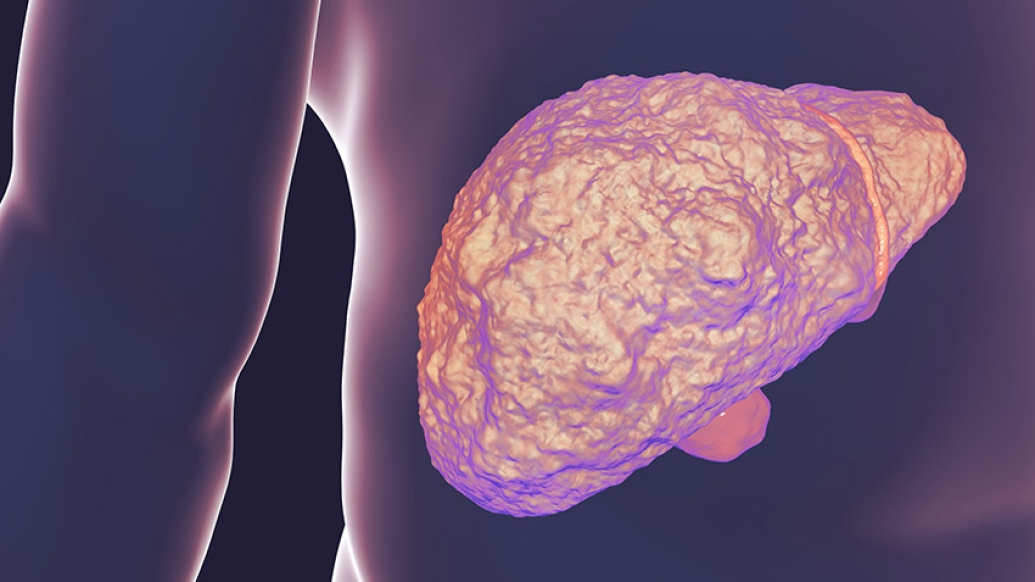U-M researchers identify a potential treatment for non-alcoholic fatty liver disease.
10:12 AM
Author |

Non-alcoholic fatty liver disease (NAFLD) is the most common form of chronic liver disease, affecting approximately 25 percent of the population, worldwide.
NAFLD often leads to nonalcoholic steatohepatitis, or NASH, which is a growing global health concern. NASH is the most severe form of NAFLD and has the potential to progress into liver cirrhosis and hepatocellular carcinoma, or liver cancer.
LISTEN UP: Add the new Michigan Medicine News Break to your Alexa-enabled device, or subscribe to our daily audio updates on iTunes, Google Play and Stitcher.
Currently, there is no Food and Drug Administration-approved treatment for the condition.
This led Luis Villacorta, Ph.D., a research assistant professor of internal medicine, to partner with a team of colleagues, including Guan (Gary) Xu, Ph.D., a research assistant professor of radiology, to examine whether nitro derivatives of unsaturated fatty acids, such as nitro-oleic acid (OA-NO2), are effective in treating NAFLD and related fibrosis.
"Both a lack of reliable non-invasive diagnostic tools and effective therapies have contributed to the fact that there still isn't a treatment for NASH," says Villacorta. "We have learned a great deal about the robust anti-inflammatory and anti-fibrotic properties of OA-NO2, so we knew that targeting both inflammation and fibrosis were important in finding an effective treatment against NAFLD."
The team's work was recently featured in EBioMedicine.
Examining the therapy
To explore the effects of OA-NO2 on the development of fibrotic NASH both in vivo and in vitro, Villacorta and his team developed a mouse model, in which both lipid accumulation in the liver and hepatic fibrosis were already diagnosed before initiating treatment with OA-NO2.
They found that the long-term administration of OA-NO2 improved the body composition and energy metabolism of mice chronically fed a high-cholesterol, high-fructose diet. They also observed an alleviated degree of hepatic steatosis, or the accumulation of fat in the liver, lobular inflammation and liver fibrosis.
MORE FROM MICHIGAN: Sign up for our weekly newsletter
These mice also showed a normalization in levels of serum alanine aminotransferase, an enzyme found in the liver. If levels are too high, it can indicate a liver problem.
"Our previous experience with nitro-fatty acids has taught us that these compounds have potent metabolic benefits as well as anti-inflammatory and anti-fibrotic properties," says Villacorta. "So, seeing these results was very telling."
The team used a non-invasive imaging approach developed by Xu and his colleagues in the U-M Department of Radiology referred to as photoacoustic ultrasound. This served as an alternative to a liver biopsy, which is the invasive technique currently used to diagnose NASH.
This scanning mechanism can resolve the molecular components of biological tissue at ultrasound resolution and further provided the team with evidence of both the initial diagnosis, and the therapeutic protection of OA-NO2 against NASH.
"Photoacoustic ultrasound has the potential to simultaneously monitor lipids and collagen, as well as hemoglobin and water content when operating at its full optical spectrum," says Xu. "Up until this point, liver biopsies were the only means of diagnosing NASH, so the use of this tool is very progressive."
Both in vivo and in vitro studies also demonstrated that OA-NO2 inhibits the biosynthesis of triglycerides, which constitute for most body fat in humans and other mammals.
Subsequently, the studies showed decreased levels of hepatocyte accumulation, which inhibited the pro-fibrotic activation of human stellate cells, which are found between the hepatocytes and small blood vessels in the liver. This led to reduced collagen depositions in the liver, overall.
Looking ahead
"We are proud to say that our team's findings expanded current knowledge regarding the benefits of nitro-fatty acids as a potential therapy against NAFLD," says Villacorta. "And while many ongoing trials involve patients with obesity that may provide evidence of the putative therapeutic benefits of nitro-fatty acids against NAFLD, our study has the potential to spur the development of OA-NO2 as an effective treatment for NASH."
Villacorta and Xu's work was supported by grants from the National Institutes of Health and the Michigan-Israel Partnership for Research and Education.

Explore a variety of healthcare news & stories by visiting the Health Lab home page for more articles.

Department of Communication at Michigan Medicine
Want top health & research news weekly? Sign up for Health Lab’s newsletters today!





